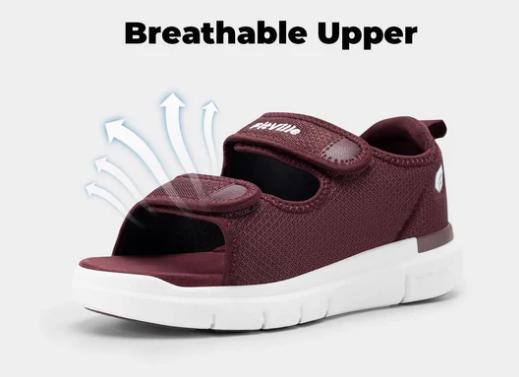For individuals with diabetes, foot health is of paramount importance. Diabetes can lead to various complications, including neuropathy (nerve damage) and poor circulation, which increase the risk of foot injuries and infections. Wearing the right shoes is a crucial step in preventing these issues and maintaining overall foot health. In this guide, we’ll explore the key features to look for in shoes for diabetics, along with top recommendations to help you make an informed choice.
Why Diabetic Footwear Matters
Diabetic footwear is specially designed to address the unique needs of those living with diabetes. These shoes provide extra protection, support, and comfort, helping to prevent foot ulcers, blisters, and other common issues. Proper diabetic shoes can reduce pressure points, accommodate foot deformities, and improve circulation, all of which are essential for preventing serious complications.
Essential Features of Diabetic Shoes
- Extra Depth and Width
- Diabetic shoes often feature extra depth and width to accommodate custom orthotics and prevent pressure points. This design allows room for swollen feet, bunions, or other foot deformities without causing discomfort.
- Seamless Interiors
- Shoes with seamless or soft, non-irritating linings help prevent chafing and blisters, which can easily lead to infections in people with diabetes. Look for shoes made with smooth materials that reduce friction.
- Cushioned Insoles
- Insoles play a vital role in cushioning the feet and providing shock absorption. Many diabetic shoes come with removable insoles that can be replaced with custom orthotics for added support.
- Arch Support
- Proper arch support helps distribute weight evenly across the foot, reducing the risk of pressure points and foot pain. This is particularly important for diabetics, who may have compromised circulation or nerve damage.
- Wide Toe Box
- A wide toe box allows the toes to spread naturally, reducing the risk of blisters, calluses, and ulcers. This feature is especially important for those with conditions like hammertoes or bunions.
- Non-Slip Outsoles
- Diabetic shoes should have non-slip outsoles to provide stability and prevent falls, which can be particularly dangerous for diabetics. Look for shoes with durable rubber outsoles that offer good traction.
- Adjustable Closures
- Velcro straps or adjustable laces allow for a customized fit, accommodating changes in foot size throughout the day due to swelling. This feature also makes it easier to put on and take off the shoes.
- Breathability
- Breathable materials, such as mesh or perforated leather, help keep feet dry and prevent fungal infections. Proper ventilation is key to maintaining foot health for diabetics.
Top Diabetic Shoe Recommendations
Here are some of the best shoes for diabetics, each designed with the specific needs of diabetic foot care in mind:
- FitVille EasyTop Diabetic Shoes
- Best for Swollen Feet: These shoes offer extra width options up to 6E, making them ideal for those with swollen feet. The adjustable Velcro straps ensure a comfortable fit, while the cushioned collar and seamless interior provide friction-free comfort.
- Propet LifeWalker Strap
- Best for Stability: Featuring a rocker bottom design and an extra-wide fit, these shoes help improve stability and reduce the risk of falls. The adjustable straps allow for easy on-and-off, while the padded collar and tongue add to the overall comfort.
- Dr. Comfort Carter
- Best for Everyday Wear: Combining style with functionality, these shoes are designed for all-day comfort. They feature a seamless, breathable upper and a protective toe box to prevent injuries. The removable insoles provide extra cushioning and support.
- New Balance 928v3
- Best for Arch Support: These shoes are equipped with Rollbar® technology to enhance stability and arch support, making them perfect for those with flat feet or overpronation. The cushioned midsole and extra depth offer superior comfort.
- Orthofeet Diabetic Athletic Shoes
- Best for Active Lifestyles: Ideal for walking or light exercise, these shoes offer ergonomic design features, including a wide toe box, cushioned insole, and lightweight construction. The orthotic insole provides excellent arch support and helps alleviate foot pain.
- Skechers GOwalk Arch Fit
- Best for Lightweight Comfort: These shoes feature the Arch Fit® insole system, which offers podiatrist-certified arch support. They are lightweight and breathable, making them perfect for everyday walking.
Tips for Choosing the Right Diabetic Shoes
- Consult a Podiatrist: Before purchasing diabetic shoes, it’s advisable to consult with a podiatrist who can assess your specific needs and recommend the best options for your foot health.
- Measure Your Feet: Foot size and shape can change over time, especially in people with diabetes. Make sure to measure both feet before buying shoes, and choose a pair that fits the larger foot.
- Break Them In Slowly: Even the most comfortable shoes may need a break-in period. Start by wearing your new diabetic shoes for short periods, gradually increasing the time as your feet adjust.
- Check for Medicare Coverage: In the United States, Medicare Part B may cover the cost of diabetic shoes if they are deemed medically necessary by your healthcare provider. Check with your insurance to see if you qualify.
- Inspect Shoes Regularly: Regularly check your shoes for signs of wear and tear, such as thinning soles or damaged linings. Replace them as needed to ensure continued foot protection.
Conclusion
For those living with diabetes, wearing the right shoes is more than a matter of comfort—it’s a crucial step in protecting your foot health and preventing serious complications. By choosing diabetic shoes that offer the right balance of support, cushioning, and protection, you can reduce your risk of foot injuries and enjoy greater peace of mind.
Remember, your feet carry you through life, and taking care of them should always be a top priority. With the right pair of diabetic shoes, you can walk confidently, knowing that your feet are well-supported and protected.

